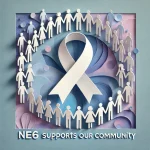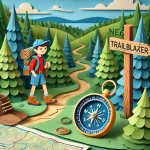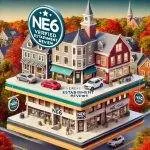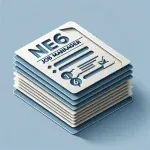Marketing and Promotion Guide (New England Edition)
Disclaimer: The information provided in this guide is intended as an overview to assist with marketing your event. It does not replace professional advice. For any legal concerns or strategic marketing consultation, we advise seeking advice from professionals in those fields.
Hey there! Johnny from NE6 here, ready to help you promote your New England event like a pro. Whether you’re gearing up for a lobster fest on the coast, a craft fair in Vermont, or a charity run in Boston, marketing and promotion are the keys to filling your event with enthusiastic attendees. This guide will take you step-by-step through creating an effective marketing strategy to get your event buzzing. Ready to dive in? Let’s get those tickets flying off the shelves!
Step 1: Understand Your Audience
Knowing who you’re marketing to is the foundation of a successful promotional campaign. Are you trying to attract locals who will stroll down the street to your event, or tourists who are planning their next getaway? Your audience determines everything from your messaging to where you advertise.
1.1 Identify Your Audience
Breaking down your target audience will allow you to craft the perfect marketing message and choose the right platforms to reach them.
- Local Residents: Ideal for town fairs, charity events, and neighborhood get-togethers. You’ll want to focus your efforts on community engagement and local pride.
Example: A farmers’ market in rural New Hampshire will likely appeal to locals looking for fresh produce and homemade crafts. - Tourists: For destination events (think Cape Cod festivals or White Mountain fall tours), aim for tourists who are planning trips to New England’s most scenic spots.
Example: A coastal food festival in Portland, Maine, should target both local food lovers and out-of-town visitors seeking a true Maine experience. - Age Groups and Interests: Identify the age range and interests of your attendees. Are they young professionals looking for a music festival, families wanting a day out, or retirees seeking a cultural experience?
Example: A music festival in Boston might attract a younger, college-aged crowd, while an apple-picking festival in Vermont is perfect for families.
Pro Tip: Create audience personas that outline key traits like age, location, interests, and event preferences. This will help you tailor your messaging and promotions effectively.
1.2 Tailor Your Message
Once you know your audience, it’s time to craft your message. Here’s how to cater your language and visuals to different groups:
- For Locals: Highlight community pride, local traditions, and familiar icons to make your event feel close to home. Use phrases like “A hometown favorite” or “Join us for a celebration of local culture.”
Example: “Come support local vendors and artisans at the annual Vermont Harvest Festival! It’s a wicked good time for the whole family.” - For Tourists: Emphasize the uniqueness and authenticity of New England, offering visitors a one-of-a-kind experience. “Discover the best lobster rolls this side of the Atlantic” or “Experience fall foliage like never before.”
Example: “Join us in celebrating the beauty of autumn with a scenic fall foliage tour and craft fair in the heart of New Hampshire.”
Graphic Suggestion: Create visuals that reflect your audience. For local-focused events, use warm, inviting colors and community-focused imagery. For tourist events, showcase picturesque landscapes, local attractions, and high-energy activities.
Step 2: Develop a Comprehensive Marketing Plan
With your audience in mind, it’s time to map out your marketing campaign. A solid plan ensures that you cover all the bases and don’t miss any opportunities to connect with potential attendees.
2.1 Build a Timeline
Your marketing strategy should follow a clear timeline that allows you to build excitement and ensure that your event stays top-of-mind as the big day approaches.
- 6-8 Weeks Before the Event:
- Announce the Event: Start with a broad announcement on your social channels, event listings, and email newsletters. This is the time to launch early-bird ticket sales or discounted group packages to generate early interest.
- Tease Key Features: Highlight special performers, activities, or vendors that will be part of your event. Start teasing these elements to give people a reason to save the date.
- 3-4 Weeks Before the Event:
- Increase Social Media Advertising: Ramp up your social media efforts, posting daily or every other day with sneak peeks, behind-the-scenes content, and reminders.
- Press and Influencer Outreach: Reach out to local newspapers, influencers, and blogs that cover regional events to get your event on their radar.
- 1 Week Before the Event:
- Final Reminders: Send final email reminders, including “last chance” calls for tickets. On social media, start countdowns (“Only 5 days left!”) to build excitement.
- Event Instructions: Provide logistical details like parking information, what to bring, or any special instructions, to ensure everything runs smoothly on event day.
Graphic Suggestion: A calendar with weekly milestones for the lead-up to your event, showing when to launch email campaigns, boost social media posts, and reach out to local press.
2.2 Set Marketing Goals
Define specific, measurable goals for your event marketing. For example:
- Increase Ticket Sales: Set goals for ticket sales at each stage (e.g., sell 25% of tickets during the early-bird phase, 50% by two weeks out).
- Boost Social Media Engagement: Aim to increase social media followers, shares, or post interactions by a certain percentage during the campaign.
Pro Tip: Use SMART goals—Specific, Measurable, Achievable, Relevant, Time-bound—to keep your marketing efforts focused and effective.
Step 3: Leverage Social Media Effectively
Social media is your best tool for building buzz and getting your event in front of a larger audience. Here’s how to craft a powerful social media presence that gets people talking about your event.
3.1 Choose the Right Platforms
Select the social media platforms that align with your event and audience:
- Facebook: Create a dedicated event page for RSVPs, share regular updates, and run Facebook ads to reach your target audience.
- Best For: Community festivals, charity events, family-friendly outings.
- Instagram: Focus on high-quality visuals and Stories that show off your event’s location, vendors, and unique features.
- Best For: Food festivals, concerts, art shows, seasonal fairs.
- TikTok: Use short-form, engaging videos to promote fun, energetic events.
- Best For: Youth-oriented events, sports festivals, or music gatherings.
Pro Tip: Use platform-specific features like Instagram Reels, TikTok trends, or Facebook Events to maximize engagement. Each platform has unique ways to capture attention, so customize your approach to fit each one.
3.2 Craft Engaging Content
Now that you’ve chosen your platforms, it’s time to post content that gets people excited.
- Visuals: Use vibrant images and videos that capture the essence of New England’s seasons, local foods, and community charm.
- Example: For a fall festival, post photos of fall foliage, pumpkins, and market stands with the tagline “The best fall event north of Boston.”
- Polls and Contests: Encourage your followers to engage by running polls (“What’s your favorite festival food?”) or contests (“Win two free tickets by tagging a friend!”).
- Countdowns: Start posting countdowns (“3 days to go until the best lobster in Maine!”) with eye-catching visuals to build excitement in the days leading up to your event.
3.3 Share Vendor and Performer Spotlights
- Spotlight Key Vendors: Highlight the vendors or performers that will be at your event. Post vendor interviews, product features, or sneak peeks of their booths.Example: “Check out @MaineBakery’s famous blueberry pies at the Coastal Food Fest—don’t miss them!”
- Collaborative Promotions: Encourage vendors and performers to promote your event on their own social media channels. Provide them with social media templates or branded content for cross-promotion.
Step 4: Partner with Local Businesses and Influencers
Working with local businesses and influencers can increase your event’s reach and provide added credibility. This section will guide you through securing these partnerships.
4.1 Build Local Partnerships
- Partner with Local Businesses: Reach out to local shops, restaurants, or breweries that align with your event’s theme. Offer them sponsorship packages or vendor space in exchange for cross-promotion.Example: A local bakery might sponsor a dessert booth at a food festival in exchange for free promotional flyers or social media posts.
- Offer Co-Branded Promotions: Collaborate with sponsors on co-branded promotions, such as giveaways, discounts, or joint social media campaigns.
4.2 Work with Influencers
- Find Local Influencers: Look for New England-based bloggers, Instagram influencers, or YouTubers who align with your event’s theme. This could be food bloggers for culinary festivals or travel influencers for destination events.Pro Tip: Offer influencers VIP access, behind-the-scenes tours, or free tickets in exchange for coverage. Their followers are likely to trust their recommendations, making this a powerful marketing tool.
Step 5: Run Paid Ads to Increase Reach
Paid advertising is a great way to reach a larger audience, especially as you get closer to event day. Here’s how to make sure your ads work for you.
5.1 Set Your Ad Budget
Determine how much you’re willing to spend on advertising. Base this decision on your event size, audience, and marketing goals.
- Pro Tip: You don’t need to spend a fortune. A small ad budget ($50-$200) can make a significant impact when spent wisely on platforms like Facebook and Instagram.
5.2 Use Facebook and Instagram Ads
- Create Facebook Event Ads: Use Facebook’s event ad feature to promote your event directly to your target audience. You can geo-target specific regions like Boston, Providence, or Vermont, or target interests like “festivals” and “local food.”
- Boost Instagram Posts: Boosting your most visually engaging Instagram posts (like shots of vendors or performers) can increase their visibility and help drive ticket sales.
Step 6: Engage with Local Media
In addition to social media, don’t forget about traditional media outlets.
6.1 Reach Out to Newspapers and Radio
- Press Release: Write a press release and send it to local newspapers and radio stations. Highlight the uniqueness of your event, especially if it ties into New England’s seasonal charm or community-focused spirit.Example: “Experience the best lobster rolls in New England at the 2024 Portland Seafood Festival—featuring live music, local vendors, and family-friendly activities.”
6.2 Run Print and Digital Ads
- Print Ads: Take out ads in local newspapers or magazines like Yankee Magazine or The Boston Globe.
- Digital Ads: Run geo-targeted digital ads focused on specific areas or interests relevant to your event. Use Facebook, Google Ads, or local online publications for effective targeting.
Step 7: Post-Event Marketing and Follow-Up
Even after the event is over, there’s still plenty of marketing to be done! Keep the momentum going with post-event content and audience engagement.
7.1 Share Event Highlights
- Post-Event Recap: Post photos and videos from the event to keep the excitement alive and show off what a great time attendees had.Example: “What an amazing weekend at #NE6CraftFest! Check out the highlights and get ready for next year!”
7.2 Collect Reviews and Testimonials
- Ask for Feedback: Send out a post-event survey asking for feedback from attendees. Use this feedback to improve future events.Pro Tip: Offer an incentive, like a discount on next year’s tickets or a giveaway, to encourage attendees to fill out the survey.
Pro Tips for Event Promotion
- Use Geo-Targeted Ads: Ensure your digital ads are targeted to people living within 100 miles of your event for better reach.
- Create Event-Specific Hashtags: Make it easy for people to find and follow your event on social media.
- Offer Incentives for Early Sales: Discounted tickets or exclusive perks for early-bird buyers help drive initial sales.
There you go—your complete Marketing and Promotion Guide for New England events! Whether you need help running social media ads, partnering with local influencers, or crafting the perfect event message, I’m here to help you every step of the way. Let’s make sure your event is a hit from start to finish!


















Leave a Reply